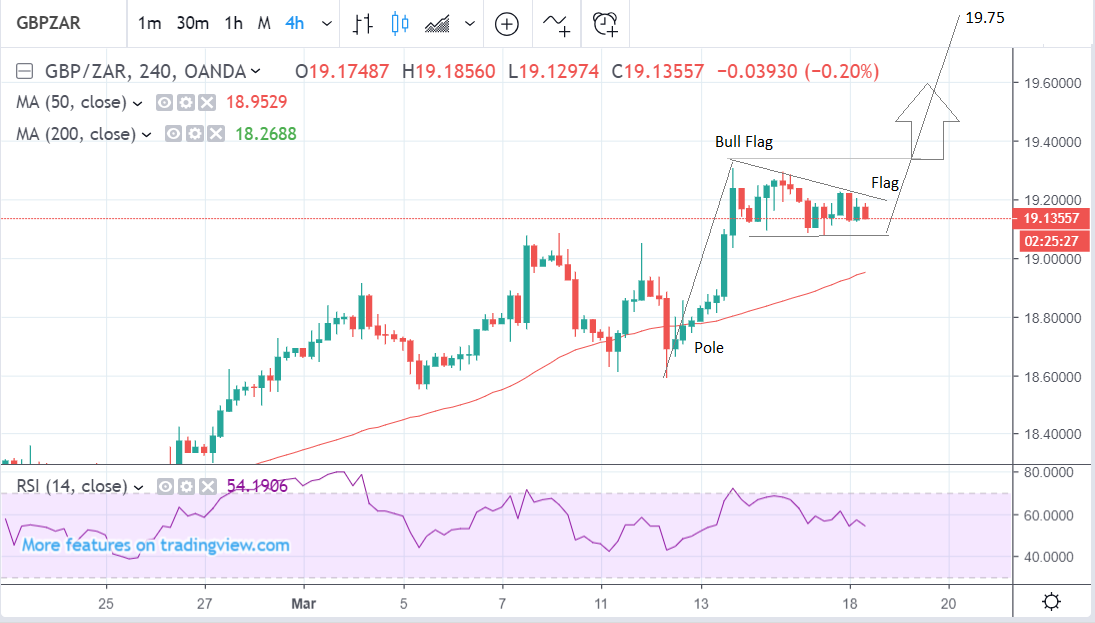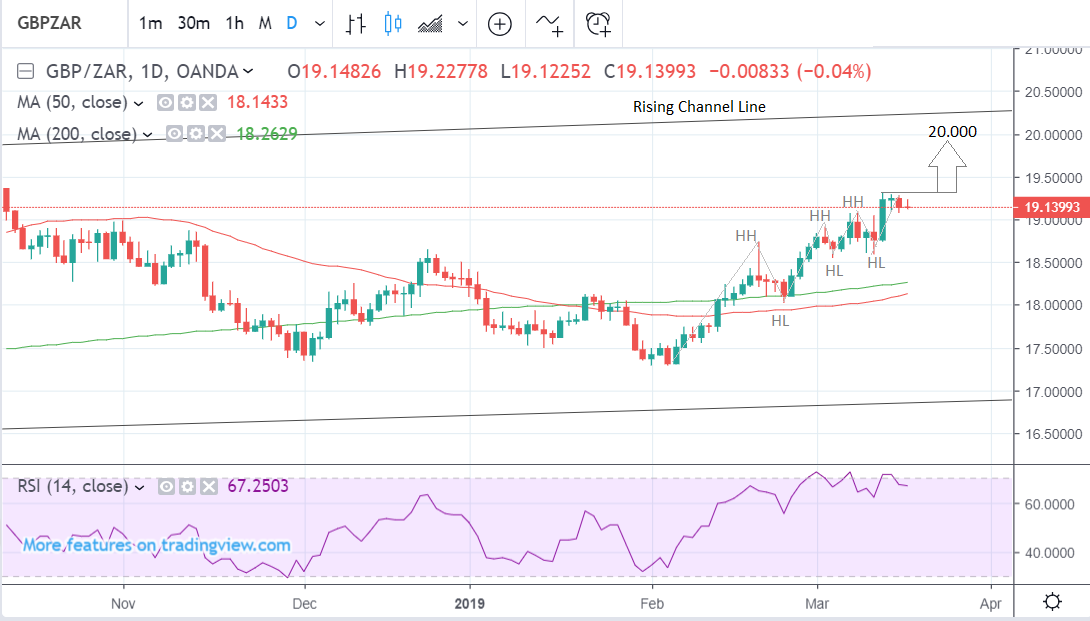The Pound-to-South-African-Rand Rate in the Week Ahead: Established Uptrend Remains Intact

Johannesburg, South Africa, Image © Adobe Stock
- GBP/ZAR uptrend is still intact and tipped to continue in medium-term
- But waning momentum means short-term bout of consolidation possible
- Brexit to decide Sterling’s course, growth expectations are key for ZAR
The Pound-to-South African Rand rate was trading 19.13 Monday after rising 1.9% during the previous week before and, although the exchange rate remains in a clear uptrend, a short-term period of consolidation cannot be ruled out for the days ahead.
Sterling rose against most rivals as a result of the option of a ‘no-deal’ Brexit being taken off the table. UK Parliament first voted to reject Theresa May’s deal again, then rejected the possibility of a hard-Brexit, and finally approved an extension to article 50, which could mean Brexit is delayed.
The Pound-to-Rand pair was helped higher by a weaker Rand, which fell due to fears of a ratings downgrade from Moody’s. The agency is due to announce its latest rating decision on March 29, althoug election uncertainty ahead of the May 8 Presidential ballot has also been a factor.

Above: Pound-to-Rand rate shown at 4-hour intervals.
From a technical perspective the uptrend is likely to continue. The pair has formed a bull-flag pattern on the 4-hour chart, which is composed of a steep rally that forms the ‘pole’, followed by a consolidation period that is denoted by a flag-looking formation.
This indicates that further gains are on the horizon if the pair can break above 19.31,which would then lead to a challenge of the 19.75 level.

Above: Pound-to-Rand rate shown at daily intervals.
The daily chart tells a similarly bullish story. The pair has been rising in a short-term uptrend ever since the beginning of February and has completed three higher-highs and higher-lows. A break above the highs could ultimately bring about a move up to the next major level of 20.00 where the market is likely to consolidate again.
Daily charts also show the relative-strength-index momentum indicator has just exited the overbought zone, which could be a sign the pair is about to correct lower in a more profound manner.
The weekly chart shows how the pair has been rising in a channel over the past two years. It is currently in an upcycle and this provides an overall bullish bias which supports an extension of the uptrend. Weekly momentum is strong and favours more gains.
Above: Pound-to-Rand rate shown at weekly intervals.
The South African (SA) Rand: What to Watch
The two main releases for the Rand in the week ahead are inflation and retails sales data. A further factor is likely to be the ongoing travails of national power utility Eskom, which has announced 12 two-hour power cuts for the week ahead.
The power cuts will hit growth by stymying commercial activity and have increased fears rating agency Moody’s may downgrade SA’s credit rating when it conducts its review on March 29 because power cuts mean lost revenue for the beleaguered Eskom.
If Moody's does cut the rating, it will push South Africa to sub-investment grade, with disastrous consequences for the currency. A rating downgrade will deter investors from putting their money into SA. Equity and bond markets have already seen net outflows rise in March due to concerns of a downgrade.
“On a net basis, foreigners sold SA bonds in March (-R4.1bn) to date, versus purchases in January (R5.2bn) and February (R13.1bn) as risk appetite in global markets has waned for SA portfolio assets. Foreigners have remained net sellers of SA equities this year, March (-R11.2bn) to date, January (-R2.5bn) and February (-R5.4bn),” says Annabel Bishop, an analyst at Investec.
Retail sales data is out at 11.00 GMT on Wednesday and is forecast to show a rebound in January of 1.4% after the poor December reading.
“We expect the data to reflect some normalisation in January. We forecast seasonally adjusted sales to rise just marginally by 0.4% m/m, leaving the y/y growth rate at 1.1% compared to a decline of 1.4% in December,” says Peter Worthington, an economist at ABSA Bank.
Inflation data is out at 8.00 on Wednesday and is forecast to show a basis point rise to 4.1% from 4.0% previously. This is mainly due to volatile food and fuel components rising. As a result, not much impact is expected on the Rand.
The Pound: What to Watch
The main fundamental driver for the Pound in the week ahead is probably developments in the Brexit process, with the Bank of England (BOE) meeting on Thursday also likely to cause volatility.
It is highly likely that the government will try, for the third time, to get its Brexit deal approved by Parliament, or failing that, that the EU will require a lengthy delay of article 50.
The latest reports from Brussels are suggesting the EU may try to make a delay conditional on either the UK having a second referendum, a general election or a very firm plan.
It is suggested this may focus minds, especially amongst Brexiteers who could fear a hijacking of Brexit if there is a delay. This will put pressure on them to accept the government’s negotiated deal.
The two most likely scenarios, therefore, are that Theresa May’s deal finally gets approved on a third attempt, or that Brexit is delayed on the condition of a referendum or general election being held.
Both would be very positive for the Pound, which compliments the overall bullish technical outlook.
The BOE meeting on Thursday, at 12.00 GMT, could also impact on Sterling. There is a risk the BOE may change its statement to reflect the recent slowdown in the economy. If so the Pound is likely to suffer.
Up until now, it had been assumed Brexit risks were the only thing stopping the BOE from raising interest rates, but the slowing economy may be providing them with other reasons not to.
“The economy has no doubt slowed but the Bank seems unwilling to shift to a more dovish stance, reasoning that it should just be patient for now as an ‘orderly’ Brexit outcome can dispel much of the uncertainty by itself and hence, kickstart investment and growth. Overall, the BoE is unlikely to deviate much from this stance, but if there is any change, it’ll probably be towards a more cautious bias,” says Raffi Boyadjian, an economist at XM.com.
From a purely hard data perspective, the main releases are employment data out on Tuesday, inflation data out on Wednesday and retail sales on Thursday.
Labour market data is expected to continue showing signs of strength, when released on Tuesday at 9.30. The unemployment claimant count is expected to have risen by only 2.7k in February - a relatively low count - the unemployment rate is forecast to be stuck at a historic low of 4.0% in January, and overall payroll count to have risen by 120k in December, according to the market consensus.
More important for Sterling, perhaps, is average earnings in January, since this has more influence over Bank of England (BOE) policy.
If average earnings rise more than the 3.4% in January (3.2% including bonuses) that is forecast, inflation will probably rise and so will interest rates - with expectations increasing that the BOE will raise them, and this will drive Sterling higher. Higher interest rates are positive for the Pound because they attract and keep greater inflows of foreign capital.
Inflation is out on Wednesday and is another key metric for the Pound. As explained above inflation influences BOE policy which impacts on the currency. In January inflation came out surprisingly lower after falling -0.8% compared to December. If inflation is also shown to be negative in February it could really drive down the Pound. Current expectations, however, are for a 0.2% rise.
Thursday sees another major data release, in the form of retail sales in February, out at 9.30. This is forecast to show a -0.3% fall from 1.0% previously. A deeper-than-expected decline, however, could trigger more weakness for Sterling.
Time to move your money? Get 3-5% more currency than your bank would offer by using the services of foreign exchange specialists at RationalFX. A specialist broker can deliver you an exchange rate closer to the real market rate, thereby saving you substantial quantities of currency. Find out more here. * Advertisement
